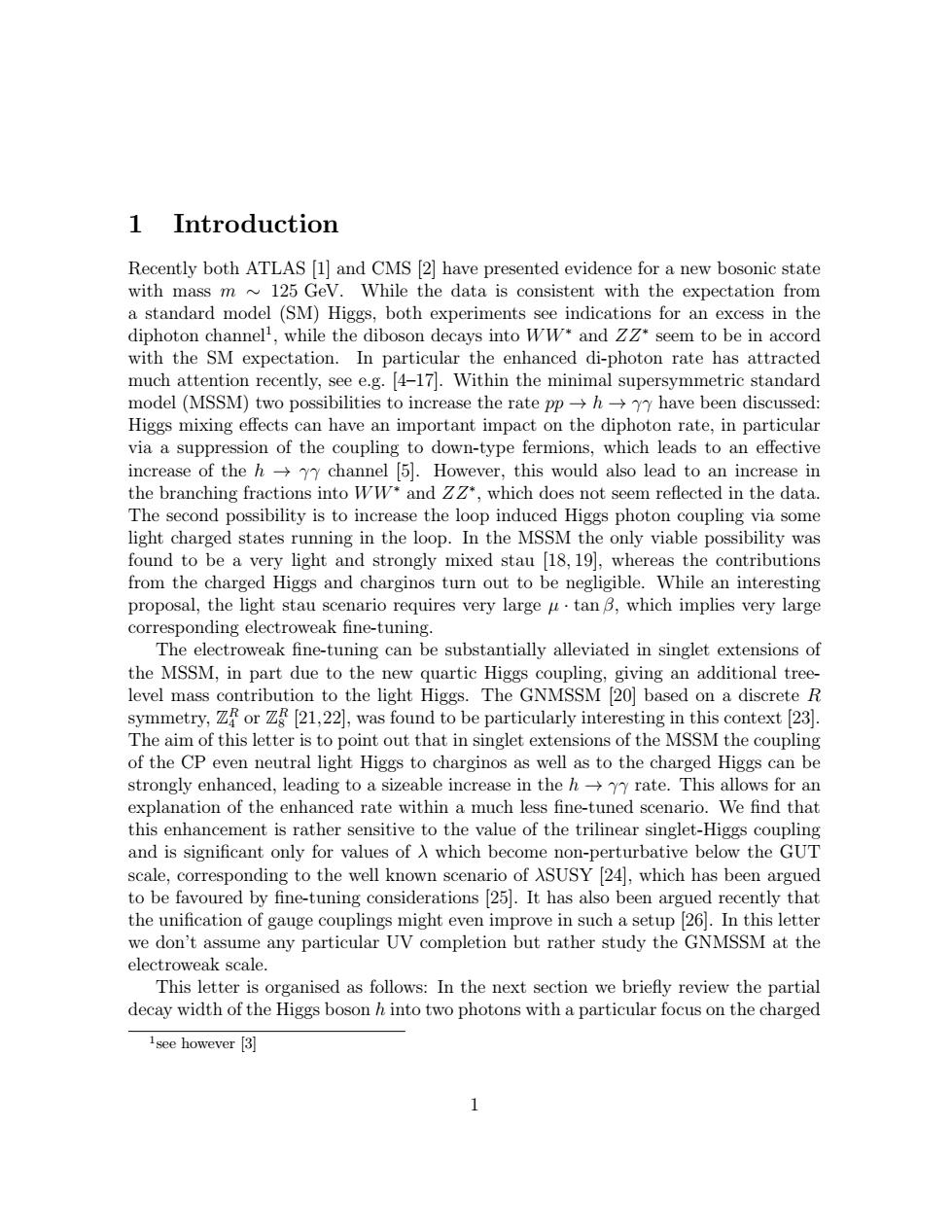正在加载图片...

1 Introduction Recently both ATLAS [1]and CMS [2]have presented evidence for a new bosonic state with mass m 125 GeV.While the data is consistent with the expectation from a standard model (SM)Higgs,both experiments see indications for an excess in the diphoton channel',while the diboson decays into WW*and 22*seem to be in accord with the SM expectation.In particular the enhanced di-photon rate has attracted much attention recently,see e.g.[4-17].Within the minimal supersymmetric standard model(MSSM)two possibilities to increase the rate pp-hy have been discussed: Higgs mixing effects can have an important impact on the diphoton rate,in particular via a suppression of the coupling to down-type fermions,which leads to an effective increase of the h-y channel [5].However,this would also lead to an increase in the branching fractions into WW*and 22*,which does not seem reflected in the data. The second possibility is to increase the loop induced Higgs photon coupling via some light charged states running in the loop.In the MSSM the only viable possibility was found to be a very light and strongly mixed stau [18,19],whereas the contributions from the charged Higgs and charginos turn out to be negligible.While an interesting proposal,the light stau scenario requires very large u.tan B,which implies very large corresponding electroweak fine-tuning. The electroweak fine-tuning can be substantially alleviated in singlet extensions of the MSSM,in part due to the new quartic Higgs coupling,giving an additional tree- level mass contribution to the light Higgs.The GNMSSM [20]based on a discrete R symmetry,Zf orZ[21,22],was found to be particularly interesting in this context [23]. The aim of this letter is to point out that in singlet extensions of the MSSM the coupling of the CP even neutral light Higgs to charginos as well as to the charged Higgs can be strongly enhanced,leading to a sizeable increase in the h-y rate.This allows for an explanation of the enhanced rate within a much less fine-tuned scenario.We find that this enhancement is rather sensitive to the value of the trilinear singlet-Higgs coupling and is significant only for values of A which become non-perturbative below the GUT scale,corresponding to the well known scenario of ASUSY [24],which has been argued to be favoured by fine-tuning considerations [25].It has also been argued recently that the unification of gauge couplings might even improve in such a setup [26].In this letter we don't assume any particular UV completion but rather study the GNMSSM at the electroweak scale. This letter is organised as follows:In the next section we briefly review the partial decay width of the Higgs boson h into two photons with a particular focus on the charged Isee however [3] 11 Introduction Recently both ATLAS [1] and CMS [2] have presented evidence for a new bosonic state with mass m ∼ 125 GeV. While the data is consistent with the expectation from a standard model (SM) Higgs, both experiments see indications for an excess in the diphoton channel1 , while the diboson decays into WW∗ and ZZ∗ seem to be in accord with the SM expectation. In particular the enhanced di-photon rate has attracted much attention recently, see e.g. [4–17]. Within the minimal supersymmetric standard model (MSSM) two possibilities to increase the rate pp → h → γγ have been discussed: Higgs mixing effects can have an important impact on the diphoton rate, in particular via a suppression of the coupling to down-type fermions, which leads to an effective increase of the h → γγ channel [5]. However, this would also lead to an increase in the branching fractions into WW∗ and ZZ∗ , which does not seem reflected in the data. The second possibility is to increase the loop induced Higgs photon coupling via some light charged states running in the loop. In the MSSM the only viable possibility was found to be a very light and strongly mixed stau [18, 19], whereas the contributions from the charged Higgs and charginos turn out to be negligible. While an interesting proposal, the light stau scenario requires very large µ · tan β, which implies very large corresponding electroweak fine-tuning. The electroweak fine-tuning can be substantially alleviated in singlet extensions of the MSSM, in part due to the new quartic Higgs coupling, giving an additional treelevel mass contribution to the light Higgs. The GNMSSM [20] based on a discrete R symmetry, ❩ R 4 or ❩ R 8 [21,22], was found to be particularly interesting in this context [23]. The aim of this letter is to point out that in singlet extensions of the MSSM the coupling of the CP even neutral light Higgs to charginos as well as to the charged Higgs can be strongly enhanced, leading to a sizeable increase in the h → γγ rate. This allows for an explanation of the enhanced rate within a much less fine-tuned scenario. We find that this enhancement is rather sensitive to the value of the trilinear singlet-Higgs coupling and is significant only for values of λ which become non-perturbative below the GUT scale, corresponding to the well known scenario of λSUSY [24], which has been argued to be favoured by fine-tuning considerations [25]. It has also been argued recently that the unification of gauge couplings might even improve in such a setup [26]. In this letter we don’t assume any particular UV completion but rather study the GNMSSM at the electroweak scale. This letter is organised as follows: In the next section we briefly review the partial decay width of the Higgs boson h into two photons with a particular focus on the charged 1 see however [3] 1